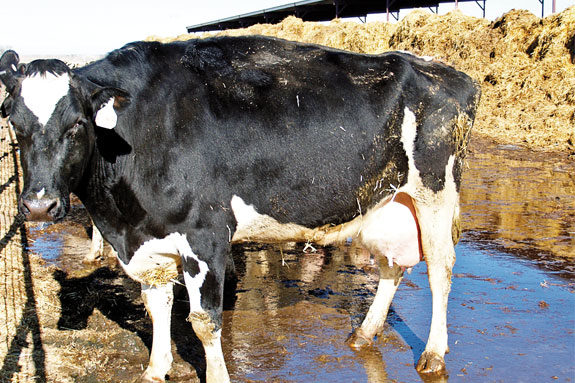Spring opens new windows of opportunity for mastitis infections to take hold. Wet, muddy conditions, especially in areas hit by heavy rainfall or flooding caused by snow melting, make it more difficult to keep cows clean. “Water is the perfect transport medium for many mastitis-causing bacteria,” says Jorge Noricumbo, quality milk manager for Pfizer Animal Health, based in Visalia, California. “A wet, muddy environment makes it easier for bacteria to enter the teat end and establish new mastitis infections. Managing mastitis is a major challenge this time of year, particularly where cows are housed in open lots or corrals.”
To avoid a spike in mastitis cases, Noricumbo suggests producers reinforce sound management practices on the dairy operation:
• Milk only clean, dry and disinfected teats on every cow at every milking. While this is always an important practice, it takes extra vigilance to make it happen in wet weather.
At first, the extra steps may add to milking time, but they are essential to help prevent mastitis and avoid losing production and quality bonuses. In some cases, time loss can be prevented by bringing cows in earlier to be washed or by adding another worker to spend more time prepping udders.
• Use a post-dip approved by the National Mastitis Council on every cow after every milking, unless harsh environmental conditions make freezing a risk. A product containing emollients will help teat skin remain soft and prevent cracking.
• Refresh milker skills with additional training sessions to reinforce the importance of thorough udder preparation and post-dipping.
• Stock up on towels, teat dips and other supplies milkers need for pre-milking and post-milking procedures. Workers should not feel a need to scrimp on these items. Large piles of clean towels reinforce the importance of sanitary udder preparation.
• Dry treat and use a teat sealant on every cow at dry-off. Work with your herd veterinarian to select a dry cow treatment appropriate for your herd, and develop an aseptic administration protocol. Make sure to properly clean the teats to help prevent new bacterial infections for the entire dry period.
• Vaccinate for Escherichia coli as part of your dry-off routine. This expands your mastitis management and helps control clinical signs associated with E. coli mastitis.
For additional tips on dry cow management, parlor routines and ways to manage your milk quality during wet or muddy conditions, visit www.milkqualityfocus.com PD
—Pfizer Animal Health news release
PHOTO
A wet, muddy environment makes it easier for bacteria to enter the teat end and establish new mastitis infections. Managing mastitis is a major challenge this time of year, particularly where cows are housed in open lots or corrals. Photo by PD staff.






